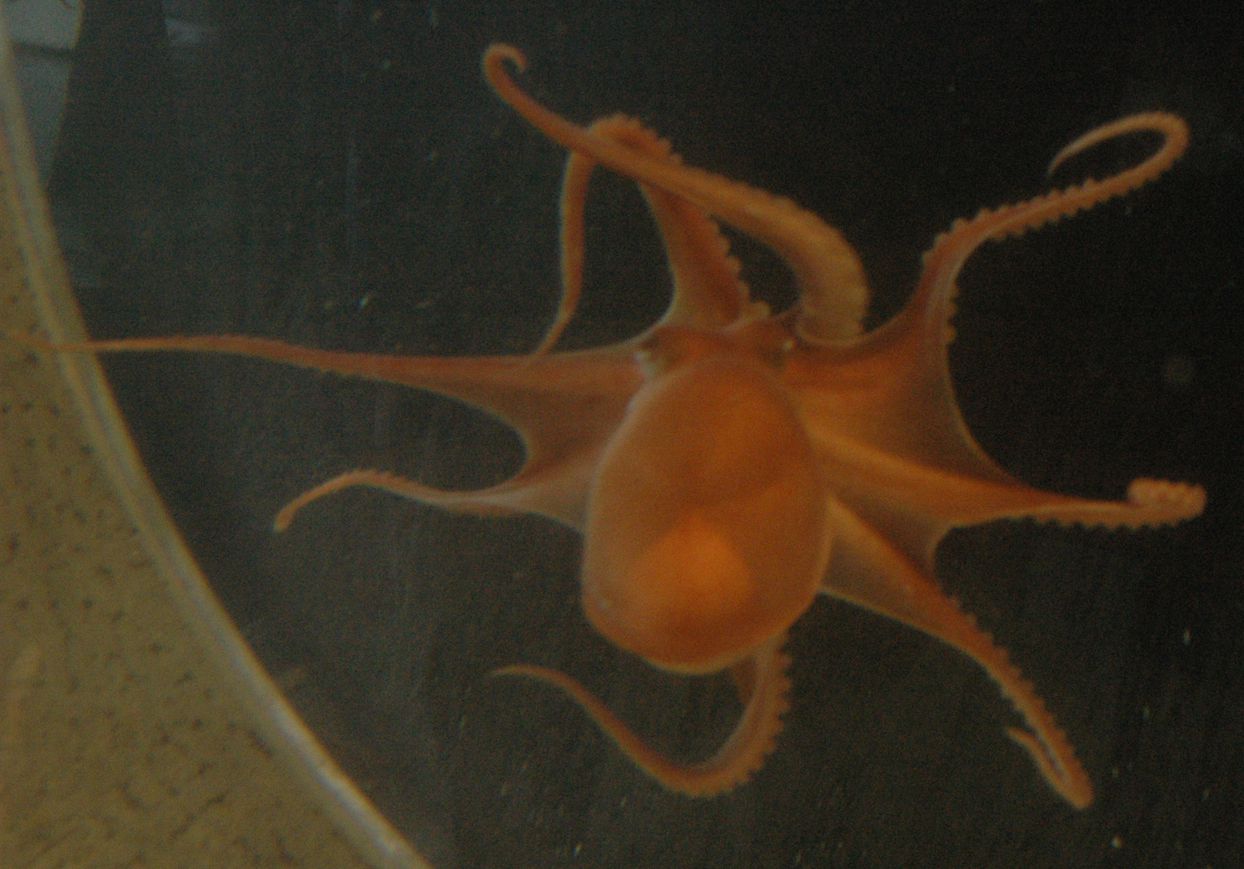Muusoctopus leioderma (Berry, 1911)Common name(s): Smoothskin octopus |
|
| Synonyms: Octopus leioderma, Polypus leioderma, Benthoctopus leioderma | 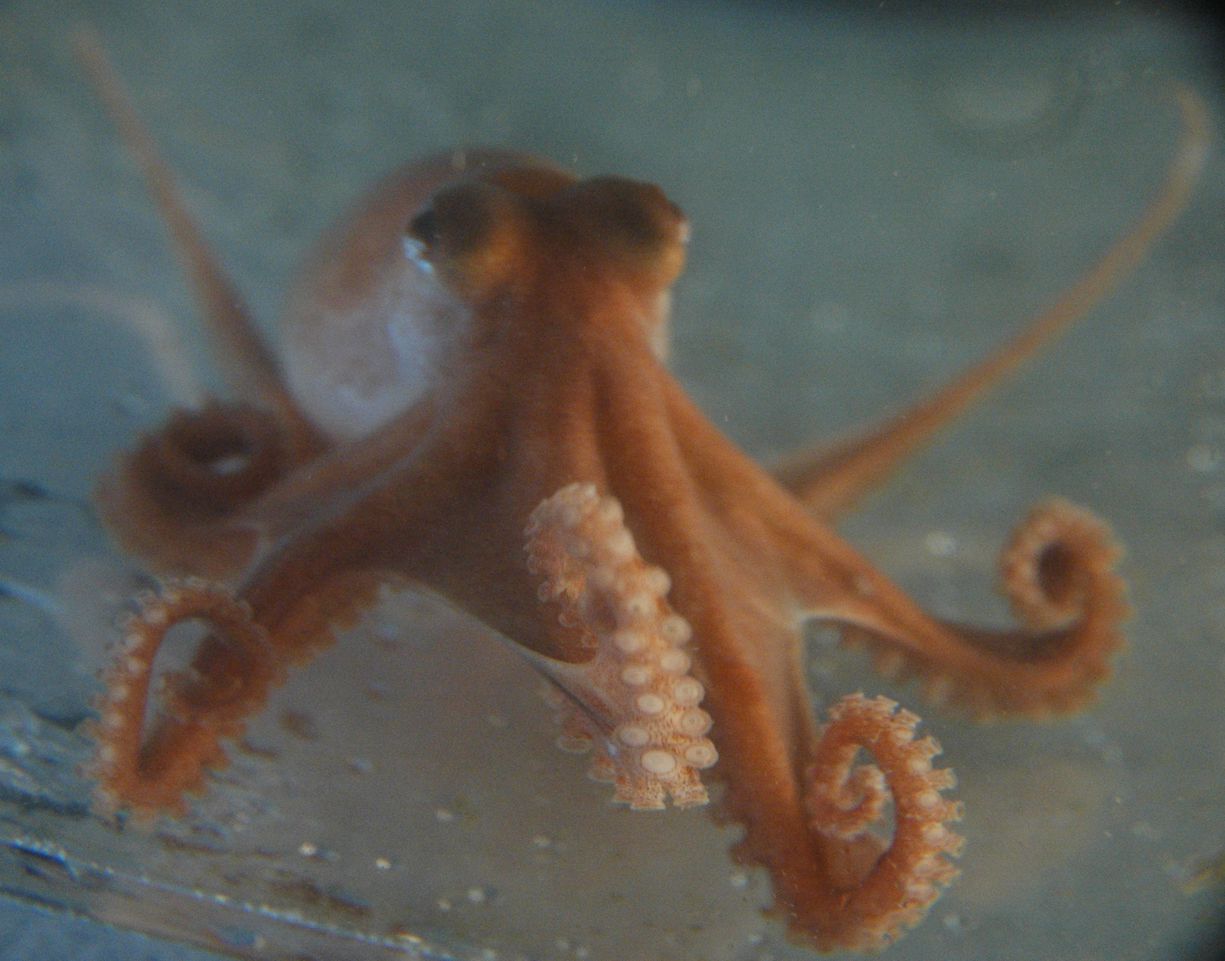 |
|
Subclass Coleoidea
Superorder
Octobrachia
Order Octopoda
Suborder Incirrina
Family Octopodidae
Subfamily
Bathypolypodinae
|
|
| Muusoctopus leioderma found at night in August on soft substrate at about 9m depth in Burrows Bay. The arm span in this position (curled end to curled end) is about 9 cm. | |
| (Photo by: Dave Cowles, August 2014) | |
Description: This species has very smooth skin (photo). It has a well-developed lateral ridge of skin around the periphery of the mantle over the mantle cavity (photo, photo). This lateral ridge is thought to be related to living in or on soft substrates (Norman, 2001). As with other Muusoctopus or Muusoctopus species, it lacks an ink sac and the suckers form 2 rows (biserial) down the arms (photo). The body is plump and compact, with the mantle widest at the posterior end and with a slight constriction towards the eyes. The eyes of this species are large and protruding when alive (photo), but may appear small and no longer protrude in preserved specimens (photo). The funnel (excurrent siphon, used for jet propulsion) is long and slender and extends well beyond the base of the arms (photo). The web is well-developed between the arms (photo), extending for over 1/4 of the arm length and continuing out to the tips of the arms as a narrow contractile membrane over most arms, but decidedly shorter than 1/4 the arm length between the two most ventral arms (photo). Color orange to grayish or purple; the lateral ridge sometimes appears green (the ridge may disappear when the animal dies) (photo). Chromatophores small and pale, of two sizes (photo). Length up to 60 cm, mantle length to 16 cm, radial (arm) span up to 30 cm. Females may be larger than males. The arms are 2-3 times as long as the body, and have about 80-100 suckers (45-61 on the male's hectocotylized arm). The hectocotylized arm (photo) of the male does not have unusually large suckers such are found on some other species such as Enteroctopus dofleini or Octopus rubescens. The dorsal arms are longer and stouter than the ventral arms (photo).
Note: One of the common characters of genus Muusoctopus is that species in the genus generally have smooth skin without papillae. However, Berry (1912), in his first detailed description of B. leioderma, reported that he found several short, obscure papillae scattered over the dorsal surface of the mantle, including one over each eye and a row of 4 between the eyes. Berry's original holotype specimen has been lost and the neotype (replacement type specimen), taken from another trawl from the same Albatross expedition, does not have these papillae, nor do other investigators report finding such papillae on other specimens. Descriptions of the species based on preserved specimens also state that the eyes are small and do not protrude, while the large protruding eyes are obvious features of the living individuals we have captured (photo).
How to Distinguish from Similar Species: Benthoctopus oregonensis is a somewhat larger, similar-appearing bathyal octopus which can be found at depths of >500 m in the Bering Sea. It has no lateral ridge, it has small suckers and small eyes, and the web between the arms is less developed. Enteroctopus dofleini may be found in similar areas but has a rough texture on the mantle skin. Octopus rubescens is similar in size but also has rougher skin and smaller eyes, plus it has 3 distinct flaps of skin (cirri) below each eye.
Geographical Range: Northern Pacific, from the Sea of Okhotsk off Siberia to California.
Depth Range: Bathyal, 250-1400 m depth (perhaps deeper), with an abundance peak in the Bering Sea of 450-650 m (Conners et al., 2012); 90-500 m (Strugnell et al., 2011). Seem to inhabit the continental slope (deeper) more than the shelf (shallower), even off Alaska; though their distribution may overlap with that of shelf species in limited areas (Conners and Jorgensen, 2007)
Habitat: Muddy or silty bottoms at bathyal depths.
Biology/Natural History: This is a common deep-water species along the continental slope, but much less common on the continental shelf. It is often found in areas where Enteroctopus dofleini are found. It has been most often observed on soft (mud or silty) substrates, into which it can bury itself. The lifespan is unknown. Mature individuals weigh <500 g (Conners et al., 2012). Prey include fishes, crabs, and other small crustaceans. Predators include skates, halibut,dogfish, rockfish, sea lions, fur seals, and beluga whales. They have been found as an important food item in the stomachs of arctic beluga whales in the Beufort Sea (Quakenbush et al., 2015).
At least some octopus of genus Benthoctopus
have been found to spawn under rock ledges and in crevices, and attach
their teardrop-shaped eggs by small stalks to the rocky substrate
(Voight
and Grehan, 2000). The female broods the large (up to 18 mm
long)
but relatively few eggs (< 200 per clutch). The newly
hatched
young are benthic
rather
than pelagic.
| Return to: | |||
| Main Page | Alphabetic Index | Systematic Index | Glossary |
References:
Dichotomous Keys: Jorgensen,
2009
(as Benthoctopus
leioderma)
General References:
Cosgrove, James A. and Neil McDaniel, 2009. Super Suckers: The Giant Pacific Octopus and Other Cephalopods of the Pacific Coast. Paperback, 208 pp. Harbour Publishing Co., Ltd., Madeira Park, B.C., Canada
Scientific Articles:
Berry, S.S., 1911. Preliminary notices of some new Pacific Cephalopods. Proceedings of the United States National Museum, 40(1838): pp 589-592
Berry, S.S., 1912. A review of the cephalopods of western North America. Bulletin of the Bureau of Fisheries XXX. Document no. 761. 336 pages and many plates (As Polypus leioderma)
Bigman, Jennifer S., 2013. Trophic ecology of the spiny dogfish (Squalus suckleyi) off central California waters. M.S. Thesis, California State University, Monterey Bay; Moss Landing Marine Laboratories. 95 pp.
Conners, M. Elizabeth, Christina Conrath, and Kerim Aydin, 2012. 22. Assessment of the octopus stock complex in the Bering Sea and Aleutian Islands. Chapter 22 in BSAI Octopus Complex, NPFMC Bering Sea and Aleutian Islands SAFE. National Oceanic and Atmospheric Administration. pp. 1887-1938
Conners, M. Elizabeth and Elaina Jorgensen, 2007. Octopus Complex. Chapter 19 in BSAI Octopus Complex, NPFMC Bering Sea and Aleutian Islands SAFE. National Oceanic and Atmospheric Administration. pp. 1082-1116
Hochberg, F.G., 1998. Class Cephalopoda: Taxonomic Atlas of the Benthic Fauna of the Santa Maria Basin and the Western Santa Barbara Channel. Volume 8 part 1: The Aplacophora, Polyplacophora, Scaphopoda, Bivalvia and Cephalopoda, pp. 1-250. P.V. Scott and J.A. Blake, Editors. Santa Barbara Museum of Natural History, Santa Barbara, CA, USA
Norman, M.D., 2001. New octopus species from Queensland, Australia. Memoirs of the Queensland Museum, 46: pp 677-690 [discusses the lateral ridge around the mantle found in octopus on soft substrates]
Quakenbush, Lori T., Robert S. Suydam, Ann L. Bryan, Lloyd F. Lowry, Kathryn J. Frost, and Barbara A. Mahoney, 2015. Diet of beluga whales, Delphinapterus leucas, in Alaska from stomach contents, March-November. Marine Fisheries Review 77(1) pp 70-84.
Sweeney, M.J. and C.F.E. Roper, 1998. Classification, type localities and type repositories of recent Cephalopoda. Systematics and Biogeography of Cephalopods. Smithsonian Contributions to Zoology 586(I-II): pp 561-599. Smithsonian Institution Press, Washington, D.C., USA
Voight, J.R. and A.J. Grehan, 2000. Egg brooding by deep-sea octopuses in the North Pacific Ocean. Biological Bulletin 198(1): pp 94-100
Web sites:
Breeding ground of another, deep-sea species, Muusoctopus robustus, studied by Monterey Bay Aquarium Research Institute (MBARI): https://edition.cnn.com/2023/08/23/world/octopus-garden-deep-sea-mystery-solved-scn
General Notes and Observations: Locations, abundances, unusual behaviors:
Although this species has previously been reported mainly from deep (bathyal) depths, Kirt Onthank has repeatedly encountered it at much shallower depths (up to 9 m) at night on soft substrates near Rosario Bay Marine Station. The animal readily burrows into the soft substrate. Many thanks to Kirt and his research group, who have made most of the individual observations reported on this page.
Unlike Enteroctopus dofleini and Octopus rubescens, in our observations this deep-living species seems to change color (using its chromatophores) very little, except for a barely perceptible lightening of the arms.
All the specimens we have caught in shallow water near Rosario have been near the smaller end of the size range for this species.
The lateral ridge seems to become less prominent after
animals have
been in captivity.
This dorsal view shows the smooth skin over the mantle. Notice also the large, protruding eyes and the well-developed web.
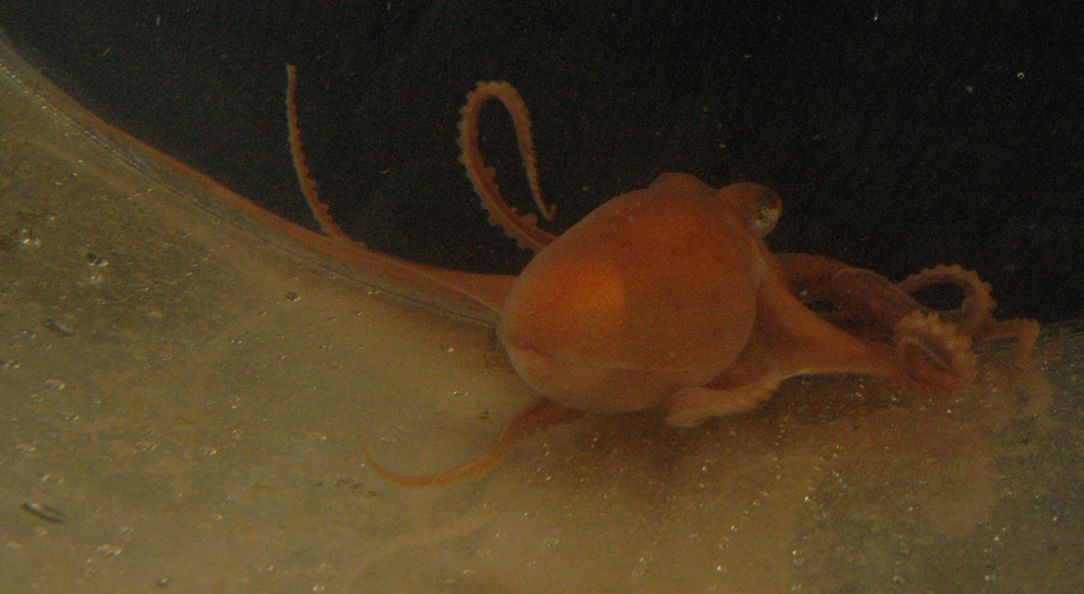
In this view the lateral ridge of skin which wraps around the mantle
cavity can be seen.

In this posterior view the lateral ridge is clearly seen.
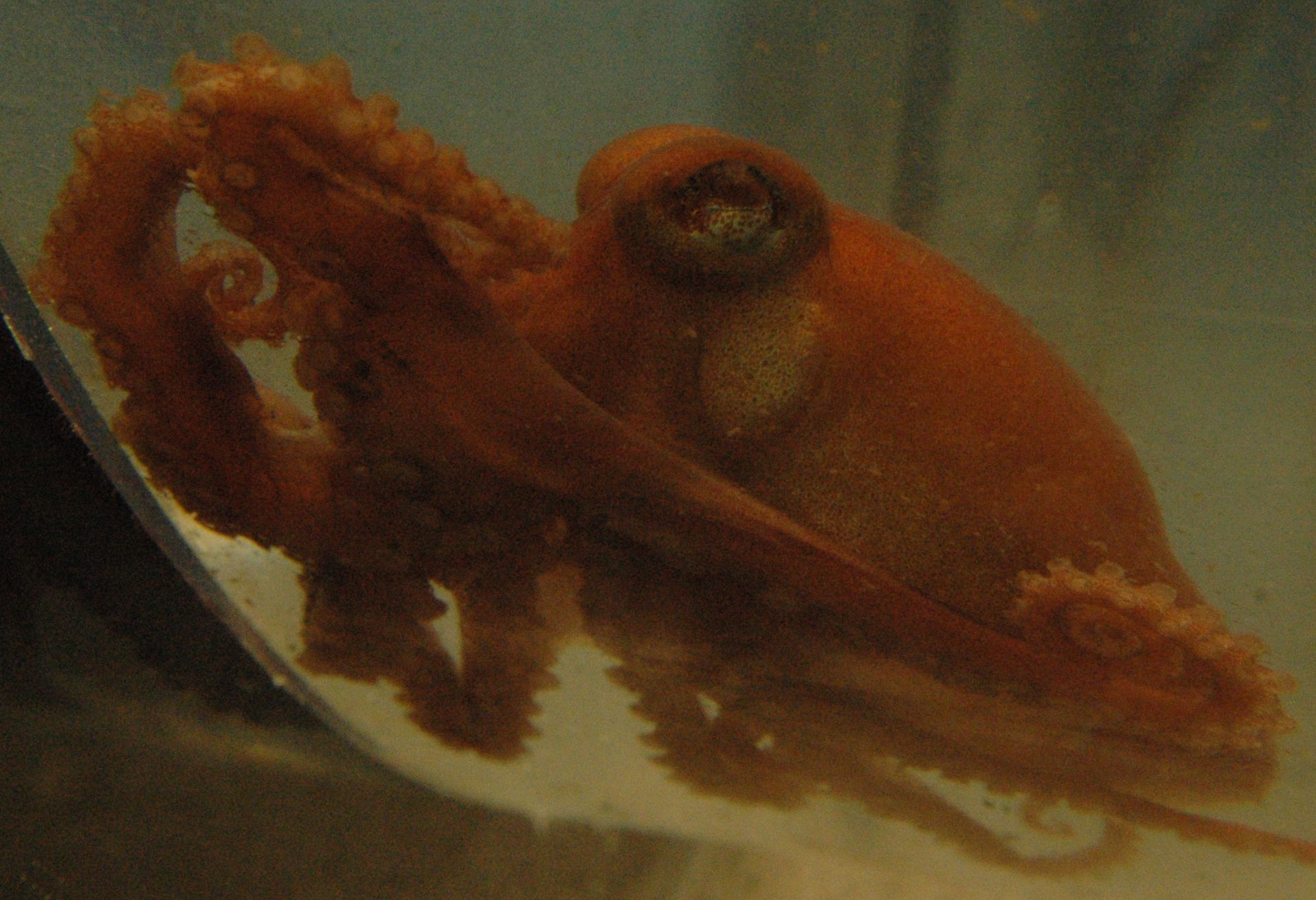
Side view. Notice the large, protruding eyes and the chromatophores.
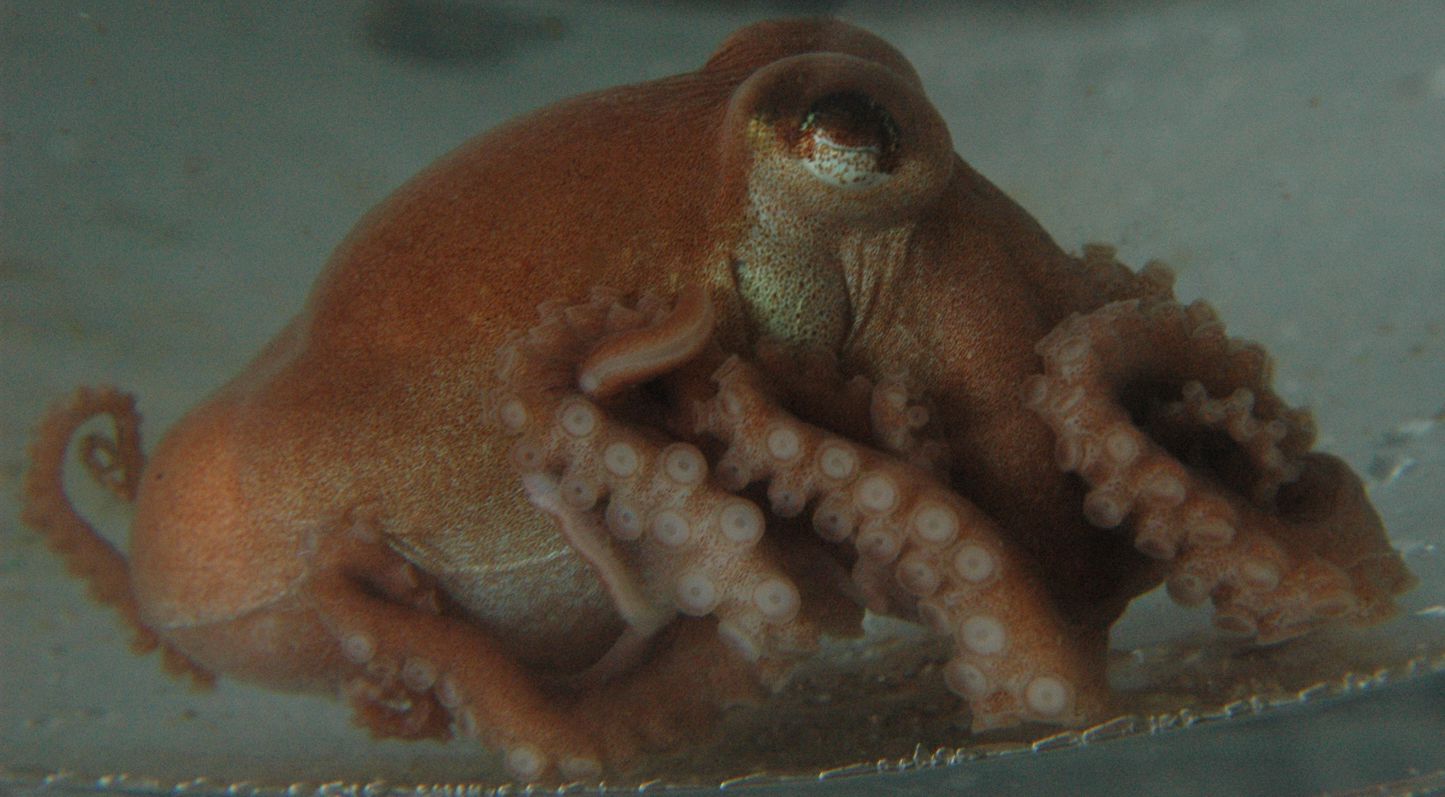
The suckers form a biserial
row. The dorsal
arms
(on the right in this
photo) are larger than the ventral
arms
(on the left).
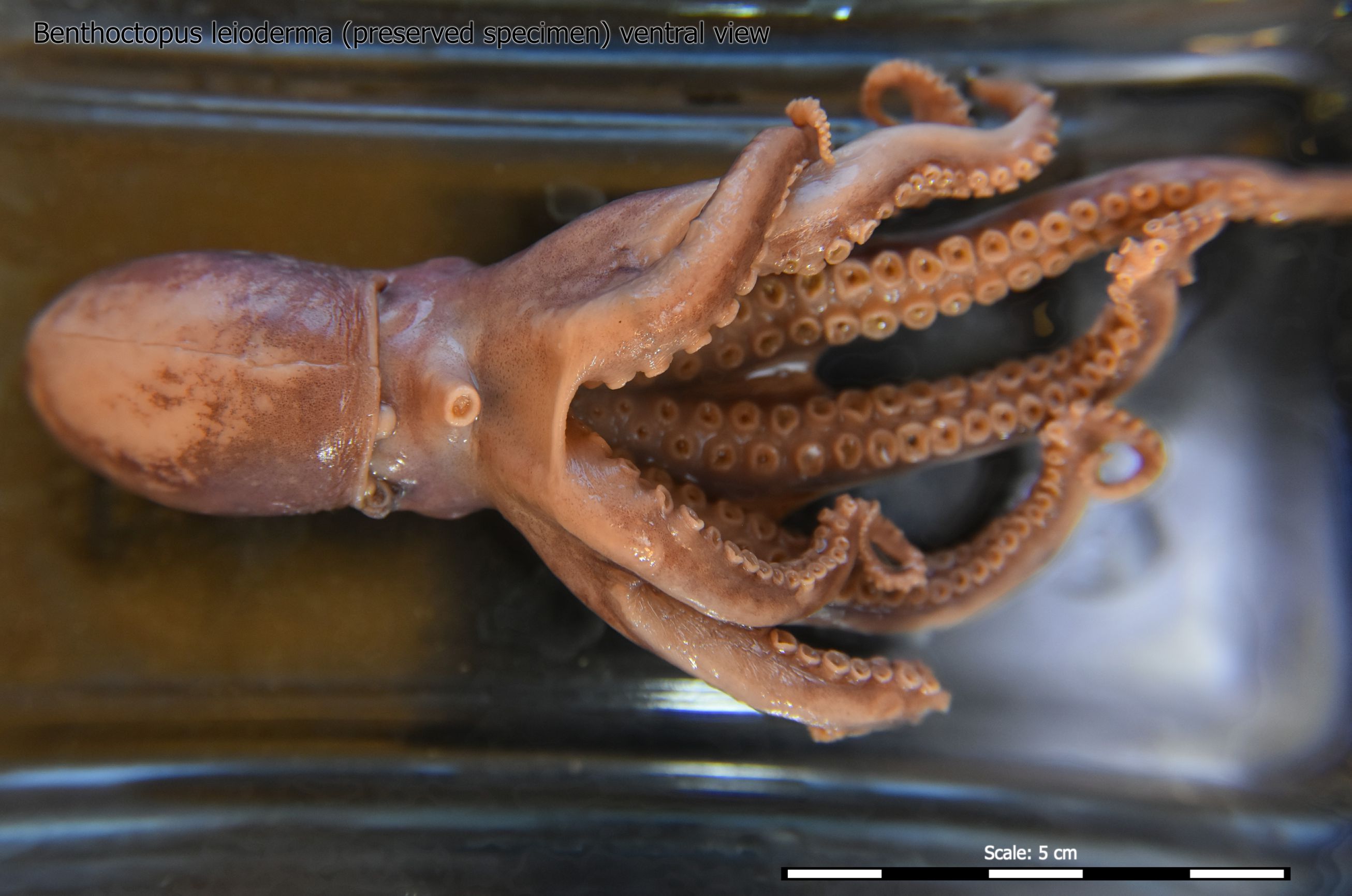
This ventral
view
of a preserved male clearly shows how the ventral
tentacles and the ventral
web
are shorter than those
on the dorsal
side.
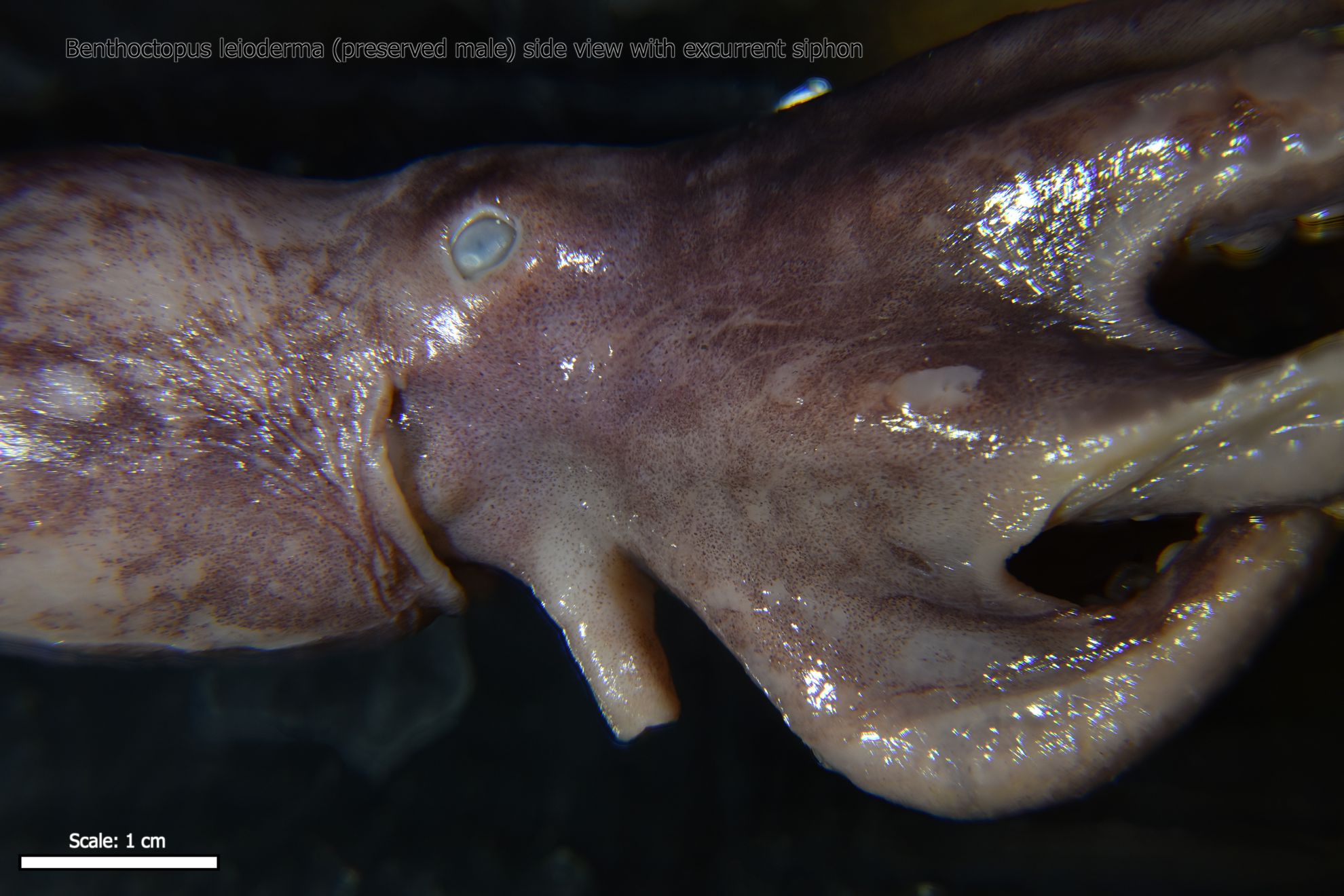
This side view of the same preserved male shows the well-developed
excurrent
siphon.
Note also that in this preserved individual the eyes appear small and
sunken
rather than large and protruding as is seen in live individuals.
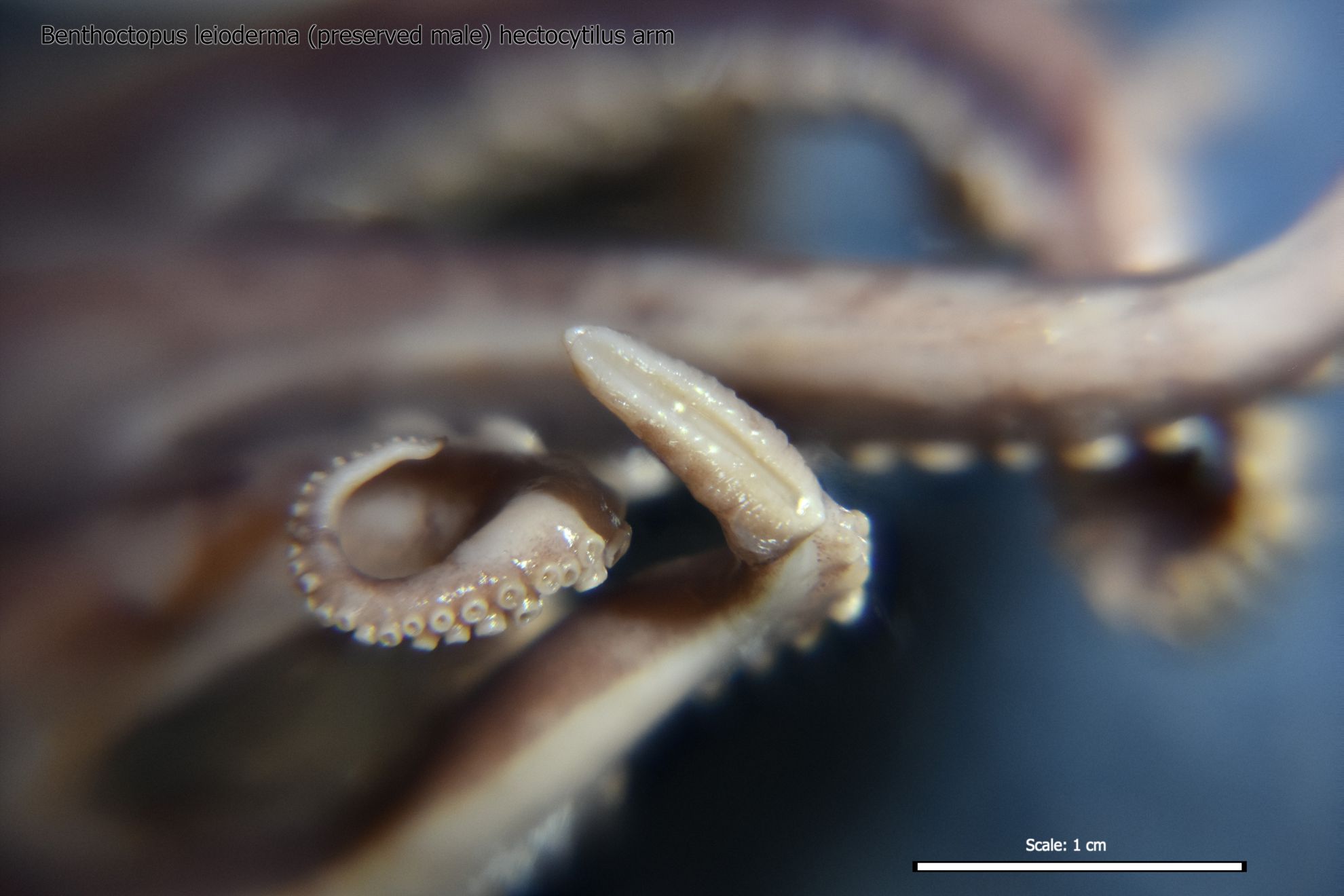
This closeup of the tips of several arms of the same preserved male
shows a normal arm (curved on the left) and the hectocotylus
arm (center, the third arm on the right of males, which has a special hectocotylus
organ on the end for transferring the spermatophore
to the female).
Authors and Editors
of Page:
Dave Cowles (2018): Created original page
CSS coding for page developed by Jonathan Cowles (2007)
Salish Sea Invertebrates web site provided courtesy of Walla Walla University
